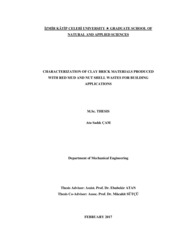Characterization of Clay brick materials produced with red mud and nut shell wastes for building applications
-
Eser Sahibi
Çam, Ata Sadık
- Tez Danışmanı Ebubekir ATAN, Mücahit SÜTÇÜ
-
Tür
Yüksek Lisans
- Yayın Tarihi 2017
-
Yayıncı
İzmir Katip Çelebi Üniversitesi Fen Bilimleri Enstitüsü
- Tek Biçim Adres Http://hdl.handle.net/11469/683
-
Konu Başlıkları
Isı yalıtımı - Seramik
Mühendislik - İnşaat
Mechanical engineering - Building
Thermal insulation - Ceramic
In this study, clay based brick with micro pores was developed for thermal insulation
in the building materials. Turkey produces about 70% of the world hazelnut
production. The aim of this thesis is to reduce the thermal conductivity coefficient by
adding organic waste (hazelnut shell) into clay mixture to form porosity during firing
of clay bricks. Moreover, it is to maintain the similar mechanical properties by
adding inorganic waste (red mud) into clay mixture. The development of a highly
porous bricks with applicable mechanical strength will contribute to save energy in
the building. The physical, mineralogical, microstructural, thermal and mechanical
properties of bricks contributing waste were investigated. Clay based brick structures
which are produced from ceramic raw materials that have large compositions, can
tolerate many waste materials with similar composition. Low water content (about
15% by weight) were applied to the clays used in the mixtures. In this work, dry
brick mixtures were prepared by adding (2.5%, 5%, 7.5% and 10% by weight)
hazelnut shell and (5%, 10%, 15%, 20% and 30% by weight) red mud to the clay.
The mixtures containing brick clay with hazelnut shell and red mud addition were
prepared in a mechanical mixer. The mixtures were pressed, dried and then fired to
obtain the highly porous durable structure. Highly porous ceramics from the mixtures
with up to 10% hazelnut shell and up to 30% red mud addition was successfully
produced. Thermal conductivities of the samples decreased from 0.78 W/mK (1.80
g/cm3) to 0.45 W/mK (1.41 g/cm3) with increasing hazelnut shell and red mud
addition. The lowest compressive strength of 9.12 MPa was found, it is appropriate
for usage. This study is an important study for recycling of waste in the thermal
insulating lightweight brick production.
-
Koleksiyonlar
ENSTİTÜLER
FEN BİLİMLERİ ENSTİTÜSÜ

 Tam Metin
Tam Metin

